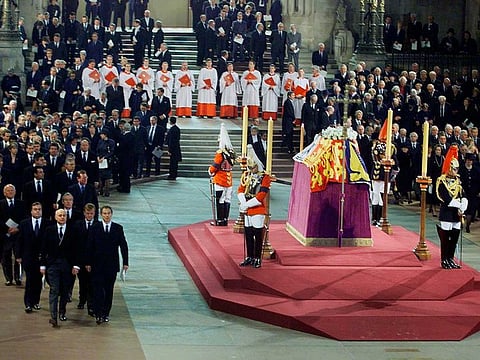Queen Elizabeth II: Lying in state, a solemn tradition
Lying in state is an honour usually only accorded to sovereigns and sometimes former PMs

London: Queen Elizabeth II will lie in state from Wednesday until a few hours before her funeral on Monday, with huge queues expected to file past her coffin to pay their respects.
What is lying in state?
Lying in state is an honour usually only accorded to sovereigns, current or past queen consorts, and sometimes former prime ministers.
Since 1910, when King Edward VII lay in state in parliament’s Westminster Hall, all sovereigns have lain in state there.
The closed coffin, covered by the royal standard, rests on a raised platform or catafalque draped in purple in the centre of the 900-year-old hall.
On top will be the Imperial State Crown with the orb and sceptre representing spiritual and temporal power.
Soldiers will stand guard around the clock in rotation, at each corner of the platform. They stand with their heads bowed and backs to the coffin.
In an event known as the Vigil of the Princes, in 1936, King George V’s four sons mounted the guard around his coffin.
In 2002, the queen mother’s four grandsons did the same.
Members of the public will file past to pay their respects.
Who was the last person to lie in state in the UK?
Queen Elizabeth, the Queen Mother, who died on 30 March, 2002, lay in state in Westminster Hall before her funeral at Westminster Abbey 10 days later.
An estimated 200,000 people viewed her coffin in person over three days. For her husband George VI, more than 300,000 subjects came.
Who else has lain in state in Westminster Hall?
Previous monarchs to lie in state in Westminster Hall include: Edward VII (1910); George V, the grandfather of Queen Elizabeth II (1936); and her father, George VI (1952).
Non-royals include 19th-century prime minister William Gladstone and World War II leader Winston Churchill.
Where did earlier sovereigns lie in state?
During the 19th century monarchs lay in state in Windsor Castle, while in the 18th century Kensington Palace was the usual venue.
Queen Victoria, in instructions left before her death, specifically requested that there should be no public lying in state.
Sign up for the Daily Briefing
Get the latest news and updates straight to your inbox



